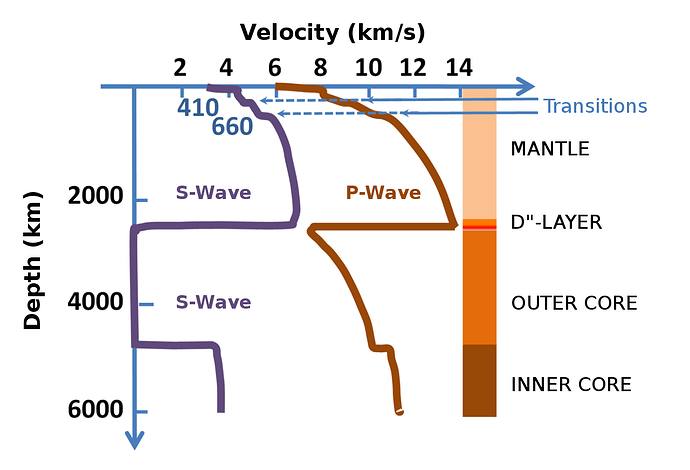Hi RS Community,
I am trying to figure out how to calculate the distance to the epicenter based on the arrival times of the P and S waves. Here is data from my station on 2023-04-13 15:54:53 of a M 6.0 in Vancouver Island Canada:
According to the app, this event happened 4341 km away from my station. It looks to me that there is a P-wave arrival around 16:02:20 and an S-wave arrival around 16:03:50 for a time delay of 1m and 30 seconds. Did I interrupt this correctly?
I am sorry for the dumb questions as I am not a seismologist but what are the speeds of P waves and S waves? I found various answers online depending on depth of the wave.
I developed a simple formula in 1 dimension for the distance away L:
L = (vp * vs)/(vp - vs) * Delta t
But I have not been successful so I am guessing I have done something wrong.
How do you do these calculations?
Thank You
Rob
2 Likes
The calculations are quite complicated for P and S waves, so I use this facility: Travel Times. You can choose which variety of P and S waves you want and also which model.
For Rayleigh and Love waves I just use a speed of 3.5 km/s.
3 Likes
Thank you for the link TideMan! I will try.
1 Like
Hello Rob,
Yes, it appears that you have two distinct arrivals on your trace, with the P wave from the earthquake reaching your Shake just before 16:02:30 UTC and the S waves peaking around 16:04:00 UTC.
No question is dumb, feel free to ask any that you have in mind, and if we can help, we will do so happily. The speed of P and S waves is not constant, as you have already found out, because the different materials and the depths the wave travels through will create discontinuities in velocity propagation.
You can see here how the speed of P and S waves changes with depth (GR Helffrich & BJ Wood (2002)):
In general, you can assume that the P wave (the faster one) travels at around 6 km/s (3.7 mi/s) and the S wave (the slower one) travels at around 4 km /s (2.5 mi/s), as illustrated here: P Wave vs. S Wave- Incorporated Research Institutions for Seismology.
Regarding finding the distance from the epicenter of the earthquake, there is a very nice tutorial here on the Michigan Tech University website that will guide you with practical examples: How Can I Locate the Earthquake Epicenter? | Michigan Technological University
3 Likes
Thank you Stormchaser! This is great info and I will study it.
The phase transitions in the velocity curves are where the wave
meets a solid to liquid interface or just any kind of interface between different
materials? It really shows how the Earth is layered. Neat.
2 Likes
For what it is worth, for relatively close earthquakes (maybe up to ~300km?) I have found that assuming 4km/sec for S and 6km/sec for P works well - distance = (6-4)*(diff in seconds).
Beyond that, you hit the “problem” well described by Stormchaser’s diagram, that speeds vary if the path is not just through crustal rock. Having multiple measurements from multiple sites helps a lot - but I don’t think that was really what you were asking about?
2 Likes
That is great info, thanks.
There is a lot I still need to learn.
Cheers
1 Like
Hello Rob,
That is correct, as the waves can cross both solid and liquid materials, which have all different properties. For example, in the image in my post, the very low S-wave velocity in the outer core occurs because it is liquid, while in the solid inner core, the S-wave velocity is non-zero.
You can find a lot about seismic waves propagation even from the basic Wiki page Seismic wave - Wikipedia and then you can expand as you wish with many online resources.
For example, you can also find a lot of material in our Educational section: https://edu.raspberryshake.org/ and also here on the IRIS Edu website: Education and Public Outreach | IRIS

